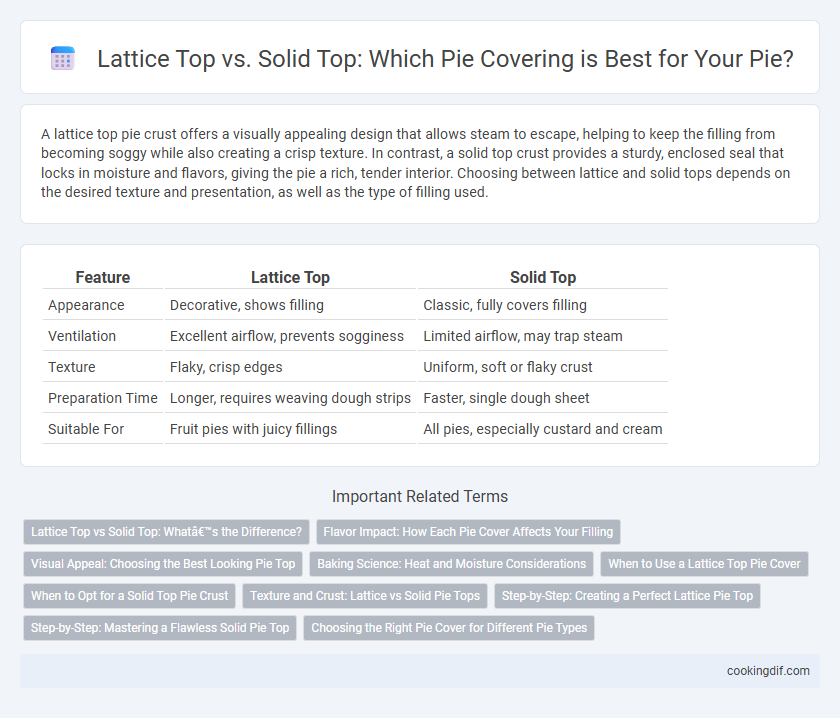A lattice top pie crust offers a visually appealing design that allows steam to escape, helping to keep the filling from becoming soggy while also creating a crisp texture. In contrast, a solid top crust provides a sturdy, enclosed seal that locks in moisture and flavors, giving the pie a rich, tender interior. Choosing between lattice and solid tops depends on the desired texture and presentation, as well as the type of filling used.
Table of Comparison
| Feature | Lattice Top | Solid Top |
|---|---|---|
| Appearance | Decorative, shows filling | Classic, fully covers filling |
| Ventilation | Excellent airflow, prevents sogginess | Limited airflow, may trap steam |
| Texture | Flaky, crisp edges | Uniform, soft or flaky crust |
| Preparation Time | Longer, requires weaving dough strips | Faster, single dough sheet |
| Suitable For | Fruit pies with juicy fillings | All pies, especially custard and cream |
Lattice Top vs Solid Top: What’s the Difference?
Lattice top pie crusts feature a woven pattern that allows steam to escape, creating a crisp, visually appealing finish that highlights the fruit filling. Solid top crusts provide a sturdier, more protective barrier, locking in moisture and delivering a tender, flaky texture that complements denser fillings like custard or pumpkin. Choosing between lattice and solid tops depends on the desired presentation, texture, and type of filling in the pie.
Flavor Impact: How Each Pie Cover Affects Your Filling
Lattice top pie crusts allow steam to escape, preventing sogginess and intensifying the natural flavors of fruit fillings by enabling slight caramelization. Solid top crusts trap moisture, creating a more tender, juicier filling but sometimes dulling the brightness of the fruit's taste. Choosing between lattice and solid tops depends on whether you prefer a crispier texture with concentrated flavor or a soft, moist filling profile.
Visual Appeal: Choosing the Best Looking Pie Top
Lattice top pies showcase a visually intricate pattern of woven dough strips that highlight the filling, creating an inviting, rustic charm that enhances the pie's overall aesthetic. Solid top pies provide a smooth, uniform surface, offering a classic, polished look that can be decorated with cutouts or glazing for added elegance. Selecting between lattice and solid tops depends on whether you prefer a detailed, textured appearance or a sleek, traditional finish to best complement the pie's style.
Baking Science: Heat and Moisture Considerations
A lattice top pie crust allows more steam to escape during baking, preventing sogginess by promoting moisture evaporation and resulting in a crispier texture. In contrast, a solid top pie crust traps steam, which can soften the filling and crust due to retained moisture, affecting the overall flakiness. Understanding these heat and moisture dynamics is crucial for achieving the desired texture and consistency in pie baking.
When to Use a Lattice Top Pie Cover
A lattice top pie cover is ideal when you want to showcase the filling's texture and colors, such as in fruit pies like cherry, blueberry, or apple, enhancing visual appeal and allowing steam to escape during baking. It works best with juicy, thick fillings that benefit from ventilation to prevent sogginess while promoting even cooking. Use a lattice top when you desire a decorative, rustic look combined with functional benefits for perfectly baked pies.
When to Opt for a Solid Top Pie Crust
Choose a solid top pie crust when baking fruit pies with juicy fillings like apple or cherry to prevent leakage and retain moisture. Solid tops are ideal for pies requiring a sturdy, uniform surface for decorative vent cutouts or an even glaze application. Opt for this crust type when the visual appeal of a seamless golden-brown top is essential or when serving pies that benefit from a rich, buttery pastry layer.
Texture and Crust: Lattice vs Solid Pie Tops
A lattice pie top offers a crispier texture and allows steam to escape, resulting in a flakier, golden-brown crust. Solid pie tops create a denser, moister crust that retains more filling juices, emphasizing a tender and uniform texture. Both styles influence the baking process and final mouthfeel, with lattice tops enhancing crunchiness and solid tops promoting a softer bite.
Step-by-Step: Creating a Perfect Lattice Pie Top
Creating a perfect lattice pie top involves weaving strips of dough over the filling in an alternating pattern, which allows steam to escape and produces a visually appealing design. This technique contrasts with a solid top crust, which offers a fully enclosed pie that retains moisture but requires venting slits to prevent sogginess. Mastering lattice construction enhances both the pie's texture and presentation, making it a popular choice for fruit pies such as apple or cherry.
Step-by-Step: Mastering a Flawless Solid Pie Top
Achieving a flawless solid pie top begins with rolling the dough evenly to avoid cracking during baking and ensuring it's chilled for easy handling. Carefully trim excess dough and use a fork or knife to vent steam, preventing soggy or bubbling crusts. Brushing the surface with egg wash enhances golden color and crispness, delivering a perfectly smooth, visually appealing pie top.
Choosing the Right Pie Cover for Different Pie Types
Lattice top pie covers offer excellent ventilation, making them ideal for fruit pies like apple or cherry that benefit from steam escaping to prevent sogginess. Solid top crusts provide a sturdy barrier, perfect for custard or cream pies where a seal is necessary to retain moisture and prevent drying. Choosing between lattice and solid top depends on the pie's filling type and desired texture, ensuring optimal baking results and presentation.
Lattice top vs solid top for pie covering Infographic

 cookingdif.com
cookingdif.com